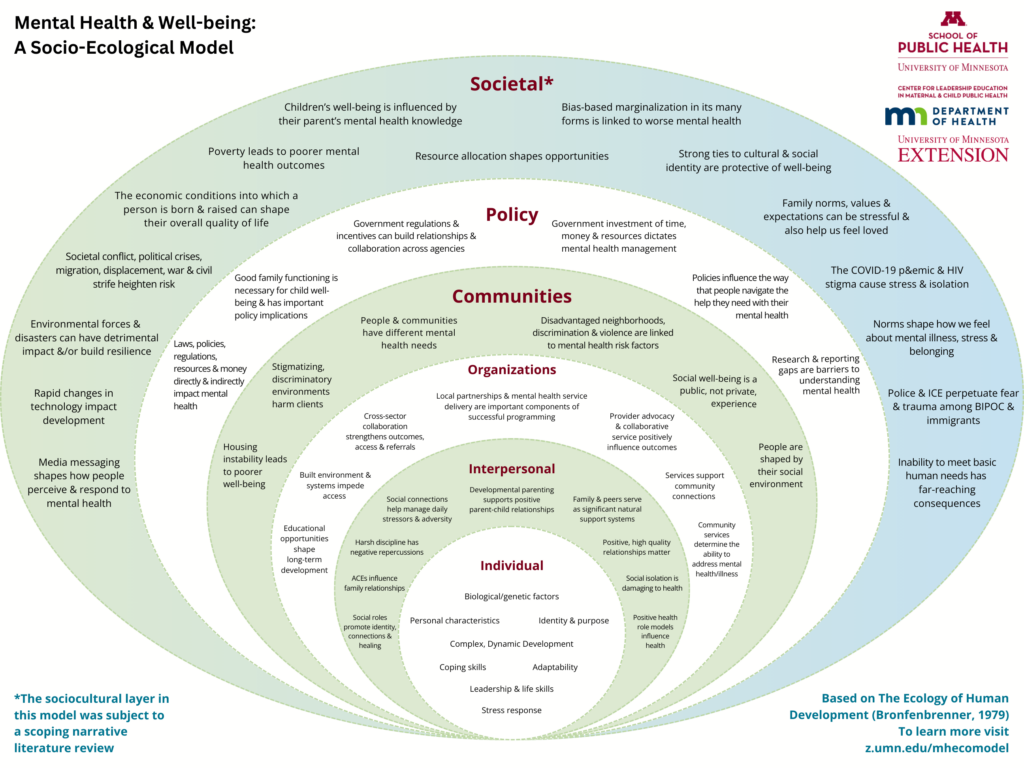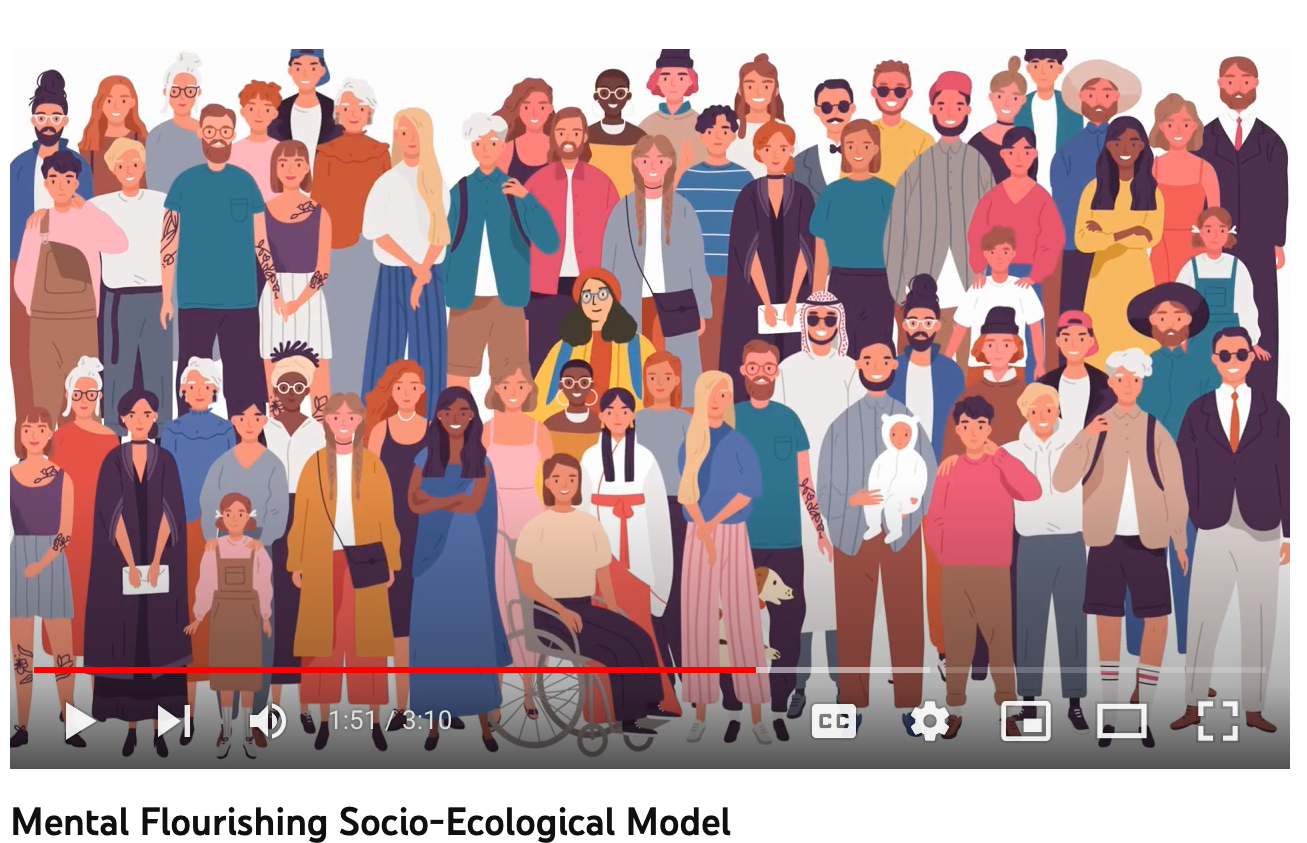About this Model
The World Health Organization (WHO) describes health as “a state of complete physical, mental, and social well-being and not merely the absence of disease or infirmity” and defines mental health as “a state of mental well-being that enables people to cope with the stresses of life, realize their abilities, learn well and work well, and contribute to their community.”
The Socio-ecological Model (SEM) recognizes that individuals affect and are affected by a complex range of social influences and nested environmental interactions. In 2020, we illustrated a Mental Health and Well-being SEM to show that individual, family, organization, community and societal factors influence mental health and well-being. Our SEM considers the whole person and mental health across the lifespan. This public health approach to mental health helps all children and families thrive mentally, socially and emotionally, with and without diagnoses.
In July 2024, we released an updated version of our Mental Health and Well-being SEM (PDF) to gather additional evidence for the societal level of the existing model.
What’s New in the Updated Model
This mental health and well-being SEM is always evolving, and its authors consider it a living document. The statements on the model address some of the “What?” (i.e., what are the influencing factors around mental health and well-being?), capturing existing research and leaving room for new findings and other ways of knowing (Rivera-Segarra et al., 2022).
Based on our extensive scoping narrative review, the updated SEM continues to expand conversations around mental health promotion, emphasizing how high-level social determinants operate through inner-layer contexts. It also offers communitarian public health action items informed by the literature, as we all have a part to play in supporting each other’s well-being.
Access the detailed report, Societal-level Determinants of Mental Health and Well-being: A Social-Ecological Model and Report, to learn more about our processes and findings.
How to Use this Model
How do we move from understanding the literature into taking action? You can start by asking:
- Where do I see myself, my work, or my organization in this model?
- To what level(s) of influence am I drawn?
- Where can I make the most impact, and where is collective effort required?
- How does this multilayered, multi-directional perspective of mental health and well-being inform my work?
Then, think about the statements below, or create your own. List some specific and actionable short, medium and long-term steps that you and/or your organization may take.
- Promote individual and family solutions to support mental well-being (e.g., self-efficacy)
- Learn and teach others to manage stress and cope with adversity
- Provide health education to support parent-child/caregiver-child relationships
- Promote social connections – between family, neighbors, employees, etc.
- Expand youth development in schools and out-of-school settings
- Increase skill-based learning to promote adaptability, coping and resilience
- Support local communities taking an active role in reducing isolation, meeting basic needs, and understanding/responding to the mental health needs of its member
- Increase collaboration between service organizations to strengthen service coverage, access and referral processes for a more integrative, comprehensive approach
- Increase natural and informal social support systems
- Address societal issues of discrimination, equity and access
- Coordinate mental health prevention efforts at the federal, state and local levels
- Explore and create prevention/promotion activities that strengthen flourishing for individuals and communities
- Fund mental health promotion research and community-based supports
- Promote equitable resource allocation
Action Steps (Societal Level of SEM)
The below have been identified as some possible steps to be taken at the societal level of the mental health and well-being SEM:
- Consider mental and social well-being in emergency preparedness efforts
- Allocate emergency resources equitably
- Mask and vaccinate to protect vulnerable and disabled folks
- Continue DEI education and discuss its effects on mental well-being
- Support BIPOC and LGBTQ safe spaces
- Educate on intersectionality
- Promote collectivism and connectedness
- Promote digital well-being efforts
- Become familiar with and educate on the dual-continuum of mental health
- Educate on bots, AI and reality grounding exercises to improve internet experiences
- Promote linguistic diversity and tolerance in all settings
- Offer resources and services regardless of citizenship status
- Improve family separation policies
- Create media toolkits to discourage rhetoric and phrases like “illegal aliens”
- Support housing access and act in solidarity with unhoused neighbors
- Promote food and land sovereignty
- Fund culturally congruent community-based clinics
- Fund and implement community-led healthcare (e.g. CHWs)
- Encourage intergenerational connection to preserve cultural traditions
- Promote mental health discussions in faith-based communities
- Educate on parenting styles and ACEs
- Improve family leave policies and livable minimum wage
- Promote LGBTQ+ inclusivity through education and policy work
- Increase transparency and accountability for police misconduct
- Dispatch mental health professionals to mental health crises
- Utilize restorative justice practices to disrupt the school-to-prison pipeline
- Educate on the history of policing and slavery
The Mental Health and Well-Being SEM in Action
Our model (SEM) was featured in the article “Promoting Wellness for an Inclusive Perinatal Population: Strategies for Counselors” (Journal of Mental Health Counseling, 2023)! The authors used our SEM to “present risk and protective factors associated with perinatal mood and anxiety disorders and apply the socio-ecological model of mental health and well-being to demonstrate how counselors can use their own and their clients’ levels of influence to promote wellness.”
MCH alumnus Paige Erickson and current MCH student Ashlee Cermak presented the poster “A Socio-Ecological Model of Mental Health & Well-being: Societal Factors” at the Minnesota Public Health Association annual conference in April 2024.
We love seeing our model referenced elsewhere, especially in scholars’ dissertations and thesis papers. See several below. Congrats to the grads/authors!
- Relationships Harm, Relationships Heal: Exploring Larger Bodied People’s Experiences of Weight Stigma and Eating Disorders in the Context of Family Relationships
- A Mental Health Professional Opinion on Family Involvement During the Treatment of Severe Mental Illness: A Multiple Case Study
- Resilience in Girlhood: An Analysis of the Social Determinants of Anxiety Disorders for Adolescent Girls
Have you used or referenced our model? We’d be happy to reference it here! Email Sara at mch @ umn.edu with details.
Food for Thought
This SEM was created to help shift the narrative about mental health and mental illness from an individual issue to include the social and environmental responsibility of others (Biglan et. al., 2013).
This model also helps to shift the mental health narrative from one focused on illness to mental well-being, or flourishing (Keyes, 2014; Keyes 2002). The context that the SEM provides helps us consider that with proper support, people with mental health diagnoses can flourish– and people without diagnoses can languish, too. A focus on mental health promotion and primary public health prevention acknowledges the importance of supporting mental well-being for everyone.
We hope this SEM will reveal a bigger picture of well-being, and prompt a range of new strategies across mental and public health.
About the Socio-Ecological Model
The “socio-ecological model” (the Ecology of Human Development) was developed by Urie Bronfenbrenner in the late 1970s, as a way to recognize that individuals affect and are affected by a complex range of social influences and nested environmental interactions. –Learn more
A Public Health Approach to Mental Health
There are many ways to understand mental health based on our experiences, families, and cultures. It’s not just about illness. We all have a state of mental health all of the time. A public health approach to mental health helps improve the mental health of all children and families, not just those with diagnoses. Learn about the differences between “mental health” and “mental illness.”
Positionality Statement
Positionality recognizes that people’s perspectives and perceptions of reality depend on how we are positioned in society including race, class, gender, and other sources of power and privilege. The authors recognize that our social positions contribute to the way this report is written and are committed to continue learning, as well as examining and unlearning our biases, and better leveraging our privilege to advocate for health equity.
The authors acknowledge that we are a group of public health professionals with ties to and funding from large academic and government institutions. The authors, are U.S.-born and racialized white, thus benefiting from systems of white supremacy and necessitating our continued antiracist education and action. Four of the authors are white women and one is a white non-binary femme–each of us hold intersecting white and cisgender privilege that the authors must leverage in our social and working lives to include transgender and gender diverse people in our equity and social justice-focused efforts.
The authors acknowledge that the UMN and MDH exist on Dakota and Anishinaabe land, where land treaties are not upheld by white settlers. We note the need to take tangible steps toward repairing damage caused by our European settler ancestors and institutions, including the genocidal and ethnic cleansing practices that continue to impact indigenous peoples to this day. The authors are intentionally educating ourselves on decolonial frameworks of mental and public health, and cite relevant work in this review. We also express deep gratitude for those who have shared these frameworks and knowledge with us through academic articles, conversation, and web resources. The authors acknowledge that within the fields of psychology, medicine, and public health, indigenous peoples’ knowledge was appropriated and stolen while they are underrepresented, exploited, and subject to violence.
Acknowledgments
The authors would like to thank everyone who has contributed to supporting this work:
–Teale Greylord, MPH, and Linda Blake for their contributions to the first iteration of this Mental Health and Well-being Socio-ecological Model (SEM)
–Shanda Hunt, MPH for helping the authors craft their search strategy
–Dr. Zobeida Bonilla for helping the authors craft their search strategy, and her additional academic support in the Maternal and Child Public Health (MCH) Program at the UMN School of Public Health
–The Spring 2023 MCH Foundations graduate students for their feedback and insightful use of this SEM
–The many scholars who have connected with us and utilized this model in their theses, dissertations, publications, courses, and elsewhere
–The many public health professionals who promote well-being in their numerous and varied positions
–The UMN Extension Department of Family, Health, and Wellbeing, the Center for Leadership Education in Maternal and Child Public Health, the Minnesota Department of Health (MDH), and all our supportive coworkers
–Extension’s Children, Youth, and Family Consortium for their “Circles of Influence in Family Development: Educational Disparities” SEM, which the original mental health and well-being SEM was based on
–The families and friends who support our well-being every day
Authors
This SEM was created by students and staff from:
–University of Minnesota, Center for Leadership Education in Maternal and Child Public Health (Paige Erickson, Ashlee Cermak, Teale Greylord and Sara Benning, mch@umn.edu)
–University of Minnesota Extension’s Department of Family, Health and Wellbeing (Cari Michaels, cmichael@umn.edu)
–Minnesota Department of Health (MDH), Child and Family Health Division (Anna Lynn, anna.lynn@state.mn.us)
–University of Minnesota, Office of Human Resources (Linda Blake, blake@umn.edu)
Suggested Citations
Suggested citations for the model and new report:
- Erickson, P.J., Cermak, A., Michaels, C., Blake, L., Lynn, A., Greylord, T., & Benning, S. (2024, July 1). Mental health and well-being ecological model. Center for Leadership Education in Maternal & Child Public Health, University of Minnesota–Twin Cities. Retrieved DATE, from https://mch.umn.edu/resources/mhecomodel.
- Erickson, P.J., Cermak, A., Michaels, C., Lynn, A., Benning, S. (2024, July 1). Societal-level determinants of mental health & well-being: A Social-ecological model and report. Center for Leadership Education in Maternal & Child Public Health, University of Minnesota–Twin Cities. Retrieved DATE, from https://mch.umn.edu/resources/mhecomodel.


